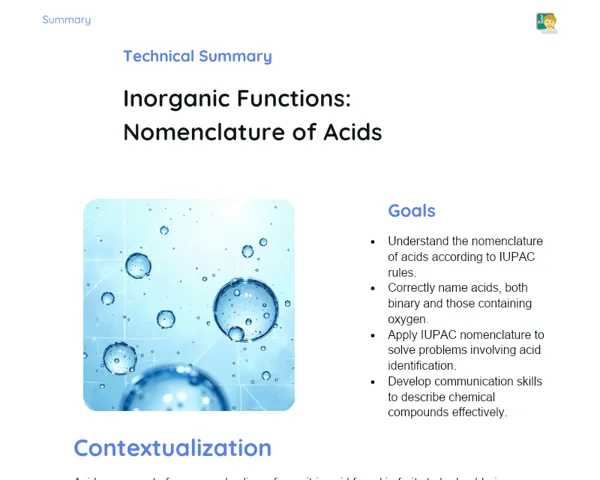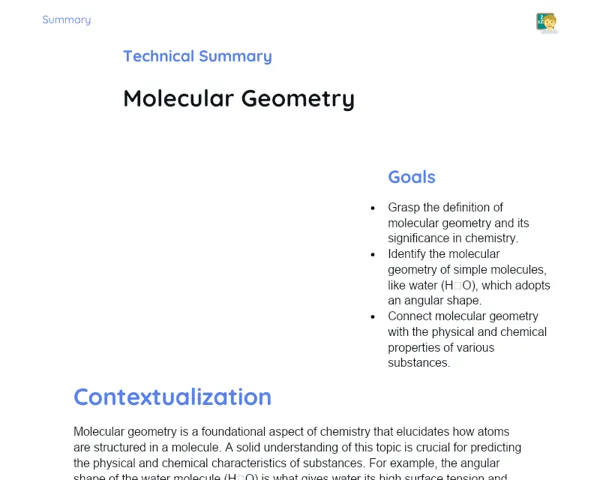Socioemotional Summary Conclusion
Goals
1. Grasp how the number of moles relates to the mass of a chemical compound using the concept of molecular mass.
2. Build the ability to calculate the mass of one mole of various substances, such as knowing that one mole of sodium weighs 23 grams.
Contextualization
Imagine you are preparing a favourite recipe and need to measure every ingredient with precision, much like following a trusted family method. Now, think of chemists who must measure substances accurately to ensure the correct chemical reaction takes place. This is where molar mass comes into play! It helps us see the link between the quantity of a substance and its mass, enabling us to make accurate and effective measurements. Learning about molar mass not only deepens our understanding of Chemistry but also reminds us that small, precise actions can lead to significant outcomes – both in science and in everyday life.
Exercising Your Knowledge
Definition of Mole
A mole is a basic unit in Chemistry used for quantifying the amount of a substance. One mole contains exactly 6.022 × 10^23 elementary entities (like atoms, molecules, ions, etc.), which is known as Avogadro's number. This number was chosen because it equals the number of atoms in 12 grams of carbon-12.
-
Measurement Unit: The mole is crucial for quantifying substances in chemistry.
-
Avogadro's Number: Represents 6.022 × 10^23 entities, a remarkably large number that helps us appreciate the scale of particles.
-
Utility: It simplifies communication and calculations among chemists worldwide.
Molar Mass
Molar mass is the mass of one mole of a substance, measured in grams per mole (g/mol). It is calculated by adding up the atomic masses of the elements present in the substance, as given in the Periodic Table. For instance, the molar mass of sodium (Na) is 23 g/mol, which means one mole of sodium weighs 23 grams.
-
Measurement: Expressed in grams per mole (g/mol), serving as a standard reference.
-
Calculation: Found by summing the atomic masses of all the elements in the compound.
-
Significance: Vital for performing chemical and stoichiometric computations in reactions.
Relationship Between Moles and Mass
The connection between the number of moles and the mass of a substance is given by the formula: n = m / M, where 'n' represents the number of moles, 'm' is the mass of the substance in grams, and 'M' is the molar mass. This relationship is key for accurately calculating the quantities of reactants and products in a chemical reaction.
-
Formula: n = m / M, which helps in determining the exact amounts required.
-
Application: Essential for stoichiometric calculations to forecast the products of a reaction.
-
Accuracy: Ensures that the reactions proceed as expected, preventing wastage or excess.
Key Terms
-
Mole: A measurement unit representing 6.022 × 10^23 particles of any substance.
-
Avogadro's Number: 6.022 × 10^23, the number of particles in one mole.
-
Molar Mass: The mass of one mole of a substance, measured in g/mol.
-
Stoichiometry: The branch of chemistry that deals with the quantitative relationships between reactants and products in chemical reactions.
For Reflection
-
How does being precise with measurements and calculations in molar mass affect other aspects of your life?
-
Recall a challenging situation you faced. Could an understanding of molar mass and its precision have helped you handle that situation better?
-
Think about a small daily habit. How might that, similar to a mole, eventually lead to a significant impact over time?
Important Conclusions
-
The interplay between moles and mass is fundamental for precise measurements in chemical reactions.
-
A proper understanding of molar mass enables us to calculate the correct amounts of reactants and products in a reaction.
-
Avogadro's number, along with the formula n = m / M, forms the cornerstone of this relationship.
-
Embracing the precision needed in chemical measurements reminds us to appreciate the value of small, careful actions in our daily routines.
Impacts on Society
Understanding molar mass has a wide-reaching impact on our everyday lives. For instance, in industries like pharmaceuticals and food production, precise measurements of chemical compounds ensure the quality and safety of the items we use and consume. Knowing how to compute molar mass helps prevent wastage and ensures that reactions occur exactly as planned, contributing to high-quality products and adherence to environmental standards.
On a personal level, the discipline and accuracy required in calculating molar mass nurture skills that are very useful in day-to-day life. By recognising the importance of precision in measuring and calculation, we can apply these principles to managing our time, finances, and resources more effectively, ultimately making us more organised and efficient. This connection between scientific precision and daily habits also bolsters our social awareness and civic responsibility.
Dealing with Emotions
When dealing with emotions while studying, try using the RULER method. First, recognize how you are feeling about your Chemistry work – be it anxiety, curiosity, or frustration. Next, understand the reason for these feelings. Perhaps the topic seems tough? Label these emotions, for example: 'I feel anxious because I haven't quite grasped the concept of molar mass.' Then, express your feelings appropriately – maybe through discussion with a friend or a quick jot in your diary. Finally, regulate these emotions by practising simple relaxation techniques such as meditation, or simply by taking short breaks during your study sessions.
Study Tips
-
Make flashcards for key terms like mole, Avogadro's number, and molar mass to help with quick revision.
-
Regularly solve problems and exercises on molar mass calculations to reinforce your understanding.
-
Form small study groups with your peers to discuss and resolve doubts, fostering richer learning and social interaction.



